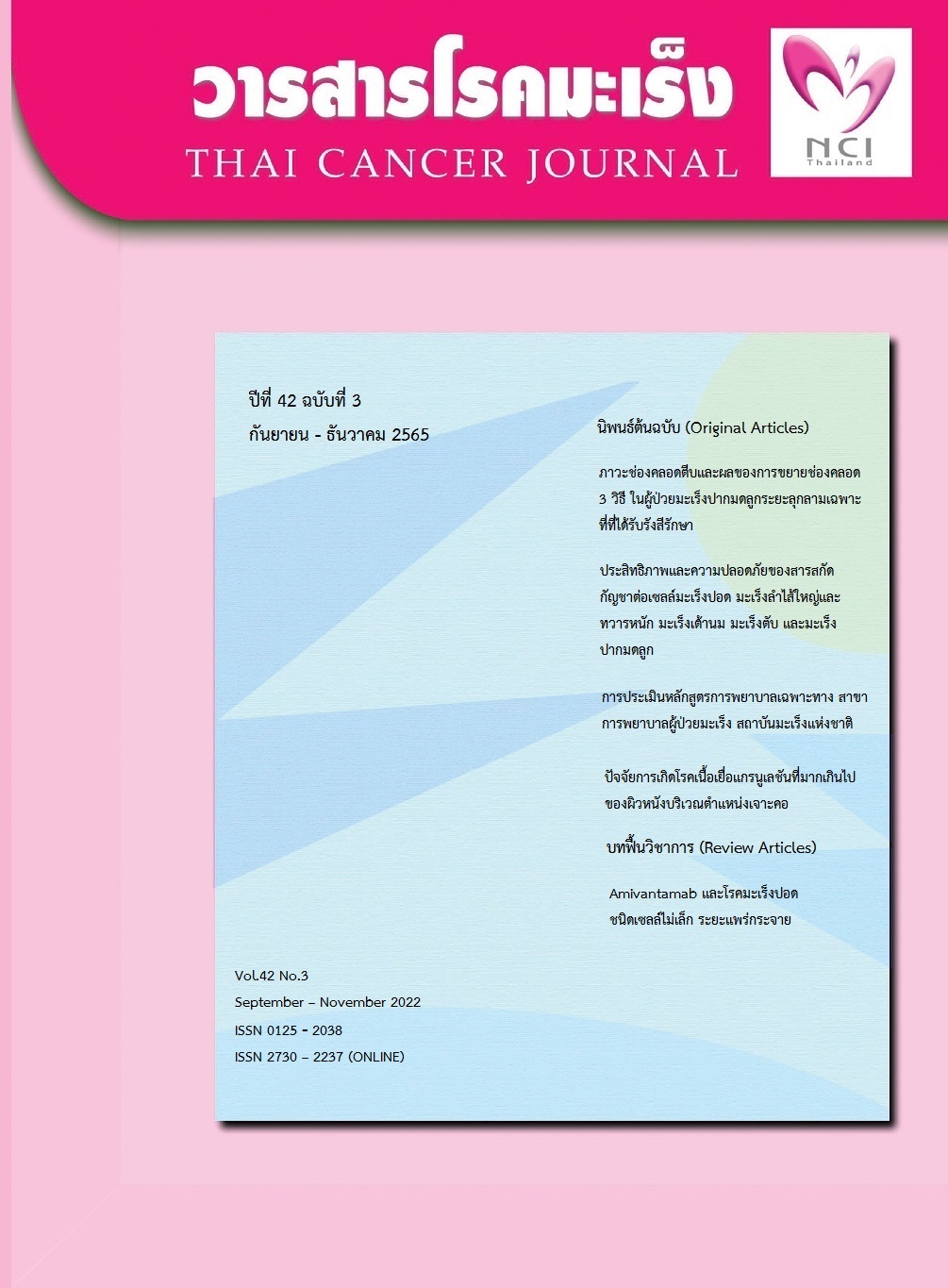Factors induce tracheostoma hypergranulation
Keywords:
tracheostoma hypergranulation, factor, bacteria, tracheotomy tubeAbstract
Objective: To evaluate the factors induce tracheostoma hypergranulation, incidence of bacteria of tracheostoma hypergranulation and type with drug sensitivity of bacteria of tracheostoma hypergranulation. Methods: The study was descriptive study. It was conducted at the King Chulalongkorn Memorial Hospital in Bangkok, Thailand. Total number of 100 patients were enrolled between February 2019 and May 2020. The data was concluded by history taking and physical examination, assessing factors induce tracheostoma hypergranulation include underlying diseases, length of tracheostomy tube used, history of antibiotic used within 1 month, history of stoma infection pneumonia or sepsis within 1 month, material of tracheostomy tube, cuff status, diameter of tracheostomy tube, frequency of inner tube cleaning and stoma status at visit period. In case of hypergranulation at stoma, biopsy was done to evaluate the type and drug sensitivity of organism. Results: Among total of 100 patients, factor induce stoma hypergranulation include history of antibiotic used within 1 month (OR 4.04 [1.22- 13.43], P= 0.023), tracheostomy tube with cuff (OR 6.25 [2.26-17.29], P <0.001), larger diameter of tracheostomy tube (OR 4.12 [1.61-10.56], P=0.003) and low frequency of inner tube cleaning (OR 5.27 [1.08-25.78], P=0.04) Incidence of bacteria of tracheostoma hypergranulation is 38.89% (14 from 36 patients), mixed types of bacteria were identified inside. According to mixed types of bacteria inside hypergranulation, drug sensitivity of bacteria wasn’t performed. Conclusion: History of antibiotic used within 1 month, tracheostomy tube with cuff, larger diameter of tracheostomy tube and low frequency of inner tube cleaning are significant associated with tracheostoma hypergranulation.The incidence of bacteria inside granulation is 38.89% mix types of bacteria were identified.
References
Kessides MC, Khachemoune A. A review of epidermal maturation arrest: a unique entity or another description of persistent granulation tissue? J Clin Aesthet Dermatol. Dec 2014; 7(12):46-50.
Vuolo J. Hypergranulation: exploring possible management options. Br J Nurs. Mar 25-Apr 7 2010;19(6):S4, S6-8. doi:10.12968/bjon.2010.19.Sup2.47244
MarianneCullen LR. Management of Hypergranulationtissue.https://www.grha.org.au/images/documentlibrary/doc_download/management_of_hypergranulation.v2.pdf
Post JC, Stoodley P, Hall-Stoodley L, Ehrlich GD. The role of biofilms in otolaryngologic infections. Curr Opin Otolaryngol Head Neck Surg. Jun 2004;12(3):185-90. doi:10.1097/01. moo.0000124936.46948.6a
SPECIMEN COLLECTION GUIDELINES. https://www.cdc.gov/urdo/downloads/specCollectionguidelines.pdf
Ledl C, Mertl-Roetzer M. Tracheal and tracheostomal hypergranulation and related stenosis in long-term cannulated patients: does the tracheostomy procedure make a difference? Ann Otol Rhinol Laryngol. Dec 2009;118(12):876-80. doi:10.1177/0003489409
Ae R, Kosami K, Yahata S. Topical Corticosteroid for the Treatment of Hypergranulation Tissue at the Gastrostomy Tube Insertion Site: A Case Study. Ostomy Wound Manage. Sep 2016;62(9):52-5.
McShane DB, Bellet JS. Treatment of hypergranulation tissue with high potency topical corticosteroids in children. Pediatr Dermatol. Sep-Oct 2012;29(5):675-8. doi:10.1111/j.1525-1470.2012.01724.x
Yaremchuk K. Regular tracheostomy tube changes to prevent formation of granulation tissue. Laryngoscope. Jan 2003;113(1):1-10. doi:10.1097/00005537-200301000-00001
Bodenham A, Bell D, Bonner S, et al. Standards for the care of adult patients with a temporaryTracheostomy; STANDARDS AND GUIDELINES. https://www.wyccn.org/uploads/6/5/1/9/65199375/ics_tracheostomy_standards__2014_.pdf
Downloads
Published
Issue
Section
License
Copyright (c) 2022 Thailand's National Cancer Institute Foundation

This work is licensed under a Creative Commons Attribution-NonCommercial-NoDerivatives 4.0 International License.
บทความทีตีพิมพ์ในวารสารโรคมะเร็งนี้ถือว่าเป็นลิขสิทธิ์ของมูลนิธิสถาบันมะเร็งแห่งชาติ และผลงานวิชาการหรือวิจัยของคณะผู้เขียน ไม่ใช่ความคิดเห็นของบรรณาธิการหรือผู้จัดทํา







